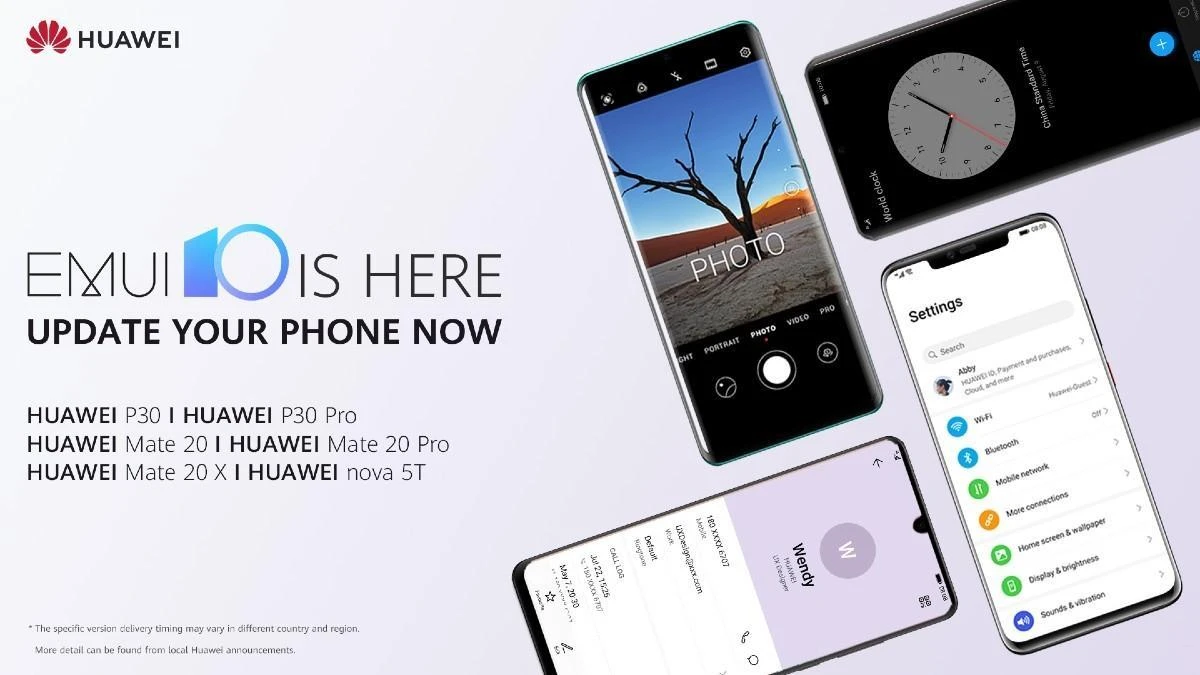Huawei has updated the list of Huawei smartphones that will get the EMUI 10 update in 2020.
Huawei has confirmed that many of its key phones will get EMUI 10 over the next few weeks. These are:
The following Huawei devices will get EMUI 10 “in later months” – a timeline that could do with a bit more clarity. However, you have have to give credit to Huawei for bringing the latest OS updates to phones from 2017 and 2018.
- Huawei Mate 20 RS Porsche Design
- Huawei Mate 20 X 5G
- Huawei P30 Lite
- Huawei nova 4e
- Huawei P20
- Huawei P20 Pro
- Huawei Mate 10
- Huawei Mate 10 Pro
- Huawei Mate 10 Porsche Design
- Huawei Mate RS Porsche Design
- Huawei Mate 20 Lite
- Huawei P Smart 2019 (sold in Japan as Huawei nova lite 3)
- Huawei P Smart+ 2019
- Huawei P Smart Pro
- Huawei P Smart Z
- Huawei nova 4
New Features of EMUI 10
A new interface
EMUI10 features an all-new interface that draws inspiration from the layout of magazines. Titles are now presented in a much larger font for emphasis, and a grid system consolidates elements across the UI to create a more focused layout that greatly improves the navigation experience. A new Morandi color palette consisting of six ashen colors add subtle elegance to the Contacts interface. App icons are revised with respect to the golden ratio for a more consistent and naturally appealing look.
The Camera app is re-designed for simplicity. Aside from the shutter button, which now has a more modernized look, the zoom bar is made larger, enabling users to more easily fine-tune the degree of magnification. Switching modes now triggers a large text prompt on the viewfinder to clearly indicate the change. Additional filters are accessible directly from the viewfinder, allowing users to easily add artistic flair to their photos even before the shot is taken.
Ergonomic Dark Mode
An all-new Dark Mode presents a more comfortable way to navigate the UI. Re-engineered based on ergonomic test results conducted by Huawei’s Human Factors Lab, the upgraded feature makes careful color adjustments to the UI to retain optimal contrast between text and the background for maximum legibility in the darkened interface. Color saturation is also adjusted so that the perceived colors are consistent between normal mode and Dark Mode.
More natural animations
UI elements now react to touch inputs quicker and in a way that is better aligned with expectation. The durations of various animations are optimized for smoothness and comfort. Tapping an object now triggers a spring motion that varies depending on the size of the element. To deliver a smoother experience, transitions now feature double the frames compared to EMUI 9.1. When users swipe up to minimize an app, the animation follows the trajectory of the swipe. The speed of the animation is based on the speed, direction and release point of the swipe, with respect to the laws of physics.
Improved performance and security
The new Deterministic Latency Engine intelligently optimizes resource allocation for foreground apps and processes to ensure they are allocated the system resources necessary for consistent optimal performance. The upgraded GPU Turbo reduces touch latency while delivering improved gaming performance and battery efficiency.
An isolated secure system is applied in EMUI10. The microkernel of this system has achieved CC EAL 5+, the highest level of security certification for consumer device OS globally. All payment, authentication and other highly sensitive operations are run on-device, preventing potential interception and theft. The connection setup, data transfer and stored information between devices are also encrypted in the system.
Multi-screen Collaboration
EMUI10 brings a new way for Huawei devices to interact with each other. Developed based on the distributed computing model, Multi-screen Collaboration enables a seamless connection between Huawei PCs and smartphones. After a simple pairing process, the smartphone can be directly controlled on the laptop display, using the peripherals connected to the PC. Transferring files between the devices is as simple as dragging and dropping. The clipboard is shared between the PC and the smartphone, allowing users to copy the text on one device and paste it on another.



